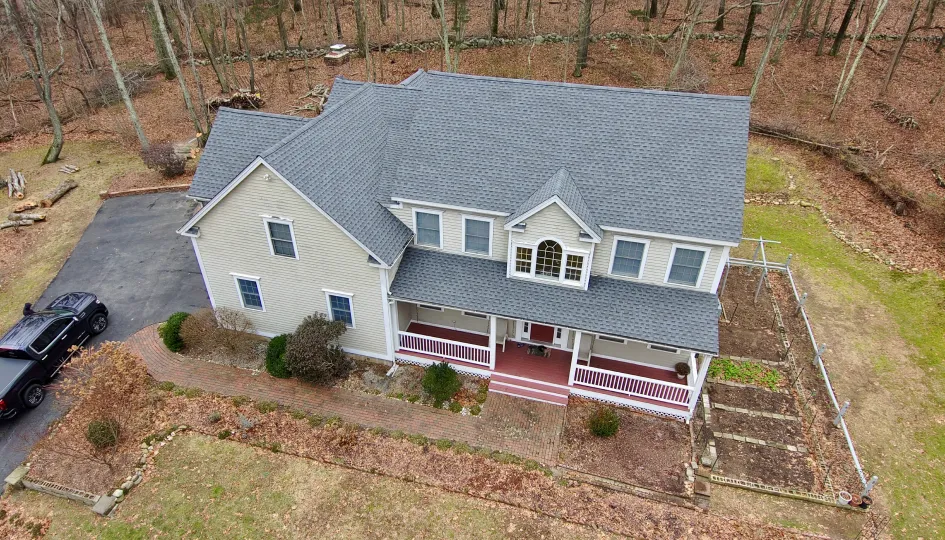Some homes sport those trendy flat roofs that scream modern living, while others reach for the clouds with peaks so steep they’d make a mountain jealous. The truth is, these aren’t just random design choices—each roofline is carefully planned to serve specific purposes, from handling harsh weather to creating that perfect curb appeal.
Whether you’re planning a renovation or just curious about why your neighbor’s roof looks so different from yours, understanding these different styles might just change how you look at every house on your block.

The Classic Gable Roof
Let’s start with America’s sweetheart of roof designs – the gable roof. You know the one: it’s that triangle-shaped roof that kids draw in their pictures. It’s trending in 2024 not just for its timeless appeal, but also because it’s incredibly practical.
Modern architects are giving this classic a fresh spin by playing with asymmetrical angles and mixed materials. The best part? It handles ventilation like a champ and sheds water faster than your dog after a bath.
Hip Roof: The All-Weather Performer
Think of hip roofs as the Swiss Army knife of roofing. With slopes on all four sides, they’re built to handle whatever Mother Nature throws at them. They’re especially hot in hurricane-prone areas because they’re more stable than their gable cousins. The latest trend is combining hip roofs with solar panels – those four slopes give you plenty of options for optimal sun exposure.
Flat Roofs: Not Actually Flat
Despite the name, flat roofs aren’t flat (mind-blown, right?). They have a slight pitch for drainage, typically about 1/4 inch per foot. Flat roofs are having a major moment in contemporary architecture, especially with the rise of rooftop gardens and outdoor living spaces. The new TPO and PVC materials are making flat roofs more reliable than ever, finally solving those dreaded leakage issues.
Mansard Roof: The Space Maximizer
These French-inspired roofs are making a comeback, especially in urban areas where space is premium. With their steep sides and flat tops, they’re like the mullet of roofs – business on top, party on the sides. They’re perfect for homeowners who might want to add an extra floor later, and they’re becoming increasingly popular in modern townhouse designs.
Gambrel Roof: The Barn Style Beauty
You might know this as the barn roof, but it’s not just for storing hay anymore. Modern architects are using gambrel roofs to create stunning vaulted ceilings and bonus living spaces. The current trend is pairing them with huge dormers and black metal roofing for that modern farmhouse look that’s all over social media.
Butterfly Roof: The Eco-Warrior
Looking like a V-shaped valley, butterfly roofs are the darlings of sustainable design. They’re perfect for collecting rainwater and supporting solar panels. Plus, those upward-angled wings create perfect opportunities for clerestory windows, flooding your space with natural light. They’re especially trending in desert climates where water conservation is crucial.
Skillion Roof: The Minimalist’s Dream
Single-slope roofs are having their Instagram moment, especially in modern and minimalist architecture. They’re simple, clean, and incredibly effective at draining water. The latest trend is using them in combination with other roof types to create interesting architectural statements.
Mixed Roof Types: The New Normal
Here’s where things get interesting. Modern homes are increasingly featuring combinations of different roof types. You might see a primary gable roof with a flat roof section for a rooftop patio, or a hip roof with multiple skillions. It’s all about customizing the roof to different areas of the home based on function.
Choosing Your Roof Type
When picking a roof style, consider:
- Your local climate (heavy snow? frequent rain? high winds?)
- Local building codes (some areas restrict certain styles)
- Your home’s architectural style
- Energy efficiency goals
- Future expansion plans
- Maintenance requirements
The Future of Roofing
The roofing industry is evolving faster than ever. We’re seeing:
- Integration of solar tiles that look like regular roofing materials
- Smart roofing systems that monitor weather and structural integrity
- Green roofing options that support environmental sustainability
- New materials that offer better insulation and durability
Each roof type comes with its own installation and maintenance requirements. Flat roofs need regular inspections for standing water, while steep roofs might require specialized equipment for maintenance. Always work with certified professionals who have experience with your specific roof type.
Conclusion
Your roof is more than just the hat your house wears – it’s a crucial system that protects your investment and defines your home’s character. Whether you’re building new, renovating, or just planning for the future, understanding different roof types helps you make informed decisions that balance aesthetics, function, and budget.
The best roof for your home depends on various factors, including your local climate, building codes, and personal style preferences. Don’t be afraid to talk to local roofing professionals about what works best in your area. They can help you navigate the options and find the perfect match for your home.
Modern roofing is all about combining tradition with innovation, creating spaces that are both beautiful and functional. Whether you go classic with a gable or ultra-modern with a butterfly roof, make sure it’s the right choice for your specific situation.
